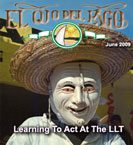Life Under Nikllai Ceausescu
By Carol L. Bowman

A steady drizzle dampened the colorless façade of a communist-era apartment building, with its crumbling concrete and rusted window frames. Un-mowed lawns, weeds three feet high and wild bushes reflected a city that had not yet rebounded from chaos. Sheltered by umbrellas, we gathered beside what used to be the Communist Central Committee Building in Bucharest, Romania to hear a survivor’s account of ‘life under Nikolai Ceausescu.’
Having visited nine post Eastern Bloc countries, we had come to expect bleak recollections from the citizens. Edmund, a stalwart looking man, arrived on site and shared events that changed his life 25 years earlier, at the age of 15. His tales of oppression, which would have collided with blue skies, mirrored the grey atmosphere. Edmund revealed that Romania’s people led the only rebellion of the European Communist countries to forcefully overthrow its leader.
On December 21, 1989, just steps away from our meeting place, the simmering revolution to overthrow the megalomaniacal leader, Nikolai Ceausescu brewed in Palace Square. From the balcony of the Central Committee Building, the brutal Party Leader had ordered the assembly of 100,000 Bucharest citizens to condemn the uprising against him a few days earlier. But rather than rally support for him, the crowd booed and hissed, waved protest signs defending the revolt, and boldly cut out the Communist shield from the center of their national flag. Young Edmund stood at the front of the throng, along with several of his teenage friends and brazenly wore Romania’s colors over his shoulders, his head poking through the space that once paid tribute to Communism. The embers of discontent burst into flame. The president and his equally tyrannical wife, Elena, unable to quell the cries for revolution, escaped from the terrace.
“Shots rang out. The Securitate, the Secret Police, sprayed the crowd with bullets,” said Edmund, as he pulled a pouch from his rain jacket and unfolded that very national banner with the hole in the center. “My best friend took a slug and died next to me, clutching onto this flag,” he said. “The next day, after protesters stormed the Central Committee Building, Ceausescu and his wife fled by helicopter,” continued Edmund. “The pilot, realizing the revolution had spread, landed near Travosite. A local doctor, promising the pair safe haven, instead took them to an agricultural center and locked them inside an office.
On Christmas,1989, a hastily assembled Liberation Military Tribunal conducted a two-hour trial and convicted the pair of genocide and abuse of power. Both faced execution by firing squad before day’s end.” Edmund smiled at the remembrance of that Christmas gift given to the Romanian people. Twenty-two years of repression extinguished in under a minute.
I felt drawn to Edmund’s story and asked him to tell more about ‘life under Ceausescu.’ “Shortages of food and electricity, escalated during the ‘80s’. Ceausescu liquidated the nation’s 11 billion dollar debt by exporting all of the country’s manufactured goods, leaving the people with nothing,’ said Edmund. “I remember having to do my homework every night by candlelight, because the electricity was cut off after 8pm. The Party censored all news, movies and books and thousands of people, hoping to eke out an existence, acted as Secret Police informants, reporting any anti-Party activity. We hung close to Radio Free Europe,” Edmund continued, looking in the distance as if recapturing those difficult times.
“Ceausescu demanded a rise in the national birthrate to expand his base of admiring comrades. Every woman of child-bearing age was expected to deliver five children and had to undergo regular gynecological exams, if she didn’t produce. Parents had nothing to feed these large families and our orphanages swelled.” Edmund’s voice turned softer, as the list of abuses grew stronger. “Ceausescu commanded that grandiose structures be erected in his honor. He forced Bucharest citizens, including children, to build without pay, the largest square foot civil building in the world, (3,700,000 square feet) the House of the Republic, today’s Palace of Parliament.”
“The worst offense,” said Edmund, “occurred while constructing the ‘Danube to the Black Sea Canal’. The Secret Police gathered up tens of thousands of educators, businessmen, and those considered bourgeoisie by Ceausescu. He ordered them brought to the Canal site and forced them to dig, their enslavement kept secret from the world.”
We stood before a man who had witnessed the toppling of a tyrant; who has used those past experiences to enlighten new generations of his people and to educate travelers about his country. The rain stopped and the greyness lifted. I will think of this scene the next time I hear ‘Romania.’
- April 2024 – Issue - March 31, 2024
- April 2024 – Articles - March 31, 2024
- April 2024 - March 31, 2024







